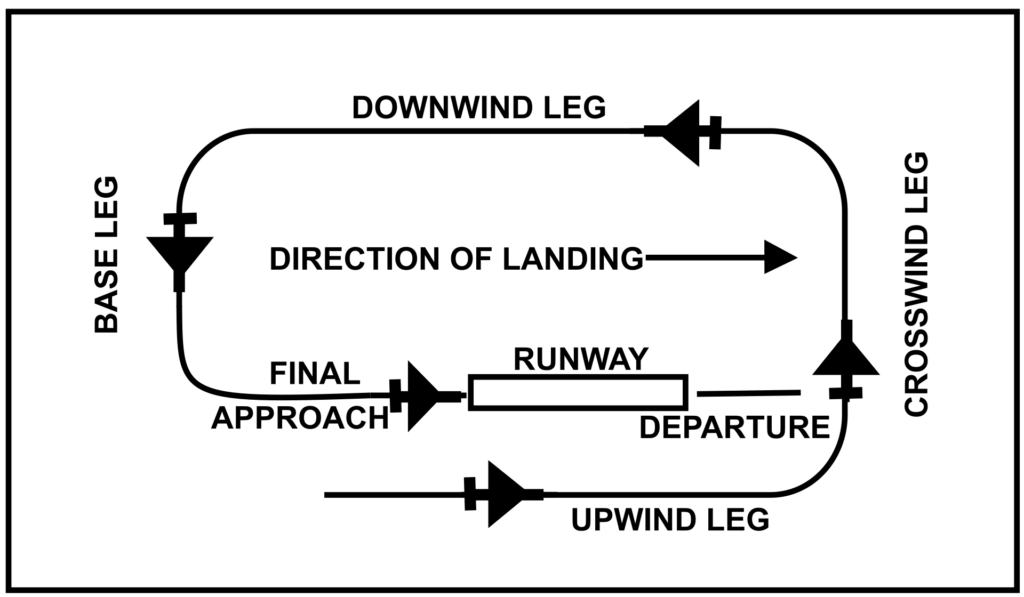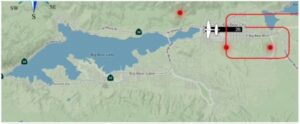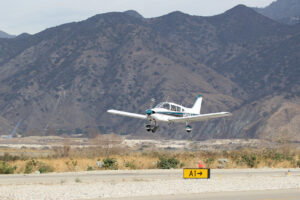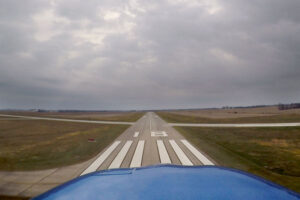The best part of flying for me was always take-offs and landings. Flying from point A to B, was ok, but depending on the length of the flight, the time between taking-off and landing can get kind of boring. We actually started taking a portable XM radio with us (this was before iPods, iPhones, etc.) and we would listen to “old-time radio stories”. We listened to stories of Sherlock Holmes, The Shadow, and Mystery Theater, and the time and terrain would fly by.
The last post left us coming back from the practice area as we finished learning some flight maneuvers. We’re headed back to the airport to land. There is a lot of instruction, both in the air and on the ground that I am kind of “gliding” over, ( no pun intended), but one of the things previously taught and instructed upon is the traffic pattern.
Traffic Pattern
There is a specific altitude to enter, terminology to use, and landmarks that can be used as turning points, Most traffic patterns are perfect rectangles for both (or all) runways. However, depending on the surrounding area, the traffic pattern will change to keep you safe. That was the case at my home airport, located in a valley with mountains on all sides, schools at each end of the runway, and a 9-mile lake at the west end, the pattern wasn’t a standard rectangle.

The first thing to understand about traffic patterns is the terminology, if you hear a plane report they are on downwind for Runway 26, you need to know where downwind is. We’ll start with “upwind”. Upwind is for entering or exiting the traffic pattern on the opposite side of the airport from downwind. “Crosswind” it’s essentially the 90-degree turn from upwind (or from departure) to set up for the next 90-degree turn to Downwind. “Downwind” is the part of the pattern the pilot gets the airplane ready for landing. “Base” is the next turn and is similar to crosswind, but on the landing end of the airport. “Final is where you should see the runway straight ahead, if you don’t, you might want to climb and figure out where you’re at. “Final” is the leg to concentrate on the landing, decreasing altitude, keeping the plane lined up with the center-line of the runway, adding and subtracting power as needed.
Truth be told, I flew as often as I could. I went for flights, sometimes just as a passenger, sometimes getting to fly on the way back, so I had at least a couple dozen landing under my belt before I actually started formal flight training. So, with that and ground school, by the time I started lessons, I had already “practiced” a little. The most comfortable part of learning to land is that instructor sitting next to you with his own set of controls. It’s that safety net in the back of your head that says, “hey, the instructor isn’t going to let you crash.”
The Landing

We entered the valley in a little upwind leg, one thing that needs mentioning is airspace, we flew out of an airport that was Class E airspace, which simply means, you don’t have to have radio communication to fly in and out. There’s a lot more, a ton more, about airspace, but again, we’re keeping it simple. So there may be planes out there without radio contact which means you need to look out the windows more often. Crosswind and base legs are great for watching out for other traffic. We turned crosswind over the opposite end of the runway and made our turn to downwind. We need to get the plane set up for landing, we need to pull back on the power to get our airspeed set, we need to maintain pattern altitude, and we can start adding flaps. There is a Pre-landing checklist on the dash, to make sure we have ourselves set.

There are many different ways you learn to land mainly for the conditions of the airport. You’ll learn, about short field, soft field, cross-wind, and of course normal landings. We’ll discuss the others later and just concentrate on normal landings for now. So we’ve come around on base and entered final. The runway looks long, we ease the nose of the airplane down to lose altitude and aim for the numbers. When you aim the nose down, the speed begins to pick up, so with one hand on the throttle, you pull off just a little more power, and slightly raise the nose like we practiced in slow flight maneuvers, but just for a few because we don’t want to get too slow. The runway always seems to be approaching too quickly, and it always feels like the airplane is too low like you may just trim the trees at the park at the end of the runway. Keeping the nose aimed at the giant numbers you feel like you may crash onto them, but as you cross the end of the runway you reduce power with one hand and pull up the nose with the other, to kinda “level off”, but you ease the nose up a little more for the right “flare”, the plane feels like its hanging there floating. As you feel the plane sink, you ease the yoke back just a little, keep it hanging just a little bit longer, then if you’ve been graceful enough the wheels touch down with a little chirp as they meet the asphalt. Now we should be able to pull the power, apply the brakes and exit the runway at mid-field. That’s a pretty good description of how the landing should be… not how my landing actually went.

My entry to the traffic pattern was pretty decent, but as we entered downwind, I was nervous, reading and re-reading the pre-landing checklist, making sure I was ready, I was a bit fast, so I pulled a little more power and raised the nose, which lost me 150 feet before I even knew it, I had to add power back in to get my altitude back, pull the power to reduce the speed, finally slow enough to add one notch of flaps. I was frantically looking around for other traffic, and it seemed every time I looked away, I lost a little altitude or got a little too fast or too slow. It didn’t feel like I could get everything together at the same time. But my instructor was right on top of everything, helping me to calm down, by the time we made the turn to base, I felt just a little more in control. He kept walking me through each movement on the controls. As we lined up for final, it was difficult to keep the plane aiming for the numbers and the centerline. I felt like we were rocking side to side, turning the yoke and dancing on the pedals, trying to find the middle. As I said before, student pilots (generally) are not graceful. We had the plane set and were actually feeling pretty good, but are we? All I could think about was how low we were getting, I thought for sure the landing gear was going to touch the tree tops, and the instructor, on the controls with me, assured me we were right where we needed to be. As we passed the numbers, I was still dancing on the pedals either to the left or to the right of the centerline, and the stall light and buzzer going off and on, and then a big thump. We were on the ground, not as smooth and gentle as it was supposed to be but we were on the ground, and the airplane was fine. I wiped the sweat from my hands on my jeans, while my feet did their best to keep the plane slowing down to the center of the runway. We were able to exit the runway at mid-field and taxi to parking without further ado.
I always feel a little exhilaration coming in for a landing, as I got better and more comfortable the landings were smoother and softer. I mentioned earlier short field and soft field. You have to learn how to take-off and land on a short field, meaning not a lot of runway, and soft field, as if you were landing off the pavement, in a field, dirt, etc. Crosswind landings are keeping the plane in a “crab” which means putting the nose of the plane in the wind, and the body of the plane is kinda side-ways to the runway, and at the last second you straighten out right before touchdown. There are also low approaches, touch-n-go’s, and then there’s the solo flight. Solo…well that’s a whole other story…